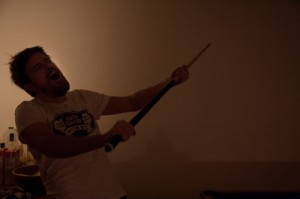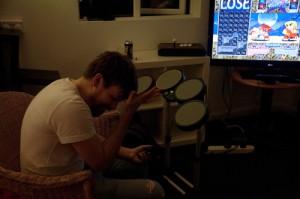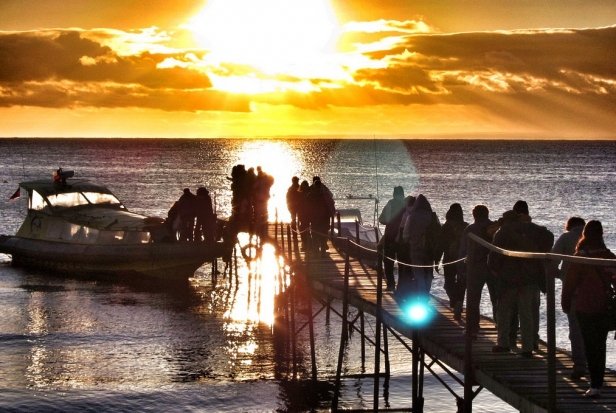
Blinkers. Yes, those things they put on horses to keep them looking straight ahead. But I’m not talking about real blinkers, no: these are special, invisible, metaphorical blinkers. In particular, I’m talking about the ones that form around the eyes of a photographer once in a while. The more you learn, the less you experiment. It’s the process of going from a hobbyist to taking photos for a living, or indeed to just having the drive and need to improve. We all get it once in a while and it can be hard to shrug off, especially when we’re looking for a new subject or concept but feel bound by the rules. So how do we start afresh? How do we tear those blinkers off (no, stop clawing at the sides of your face – like I said, they’re metaphorical blinkers) and find a fresh new approach? This week, I think I found the answer: you have to remind yourself that photography is fun.

Baileys - the smile maker.
At the moment, I’m undertaking a couple of portraiture projects. One of them was born of frustration, of sorts, at feeling like I had no ideas, or that anything I could think of only took a quick trip to google to discover that it had already been done. Of course it had: seeing as there are 7 billion people in the world (that’s right, I read the news), it’s quite likely that someone has had a similar idea to your incredible, totally original megaplan that just formed in your massive, omnipotent, glowing master brain. Any project I could think of seemed boring, limp, overdone, predictable, stiff, stupid, silly. The only photo work I was doing was commissioned stuff – stuff I’ve been doing for a while for which I have naturally developed a pattern. This is an inherently human problem: we are genetically programmed to recognise and find comfort in patterns, yet simultaneously, we get tired of repetition. We need variety, change, difference. This is why we are often warned about photography as a job, because we find that when it goes from a creative pastime to something we do as a matter of course or a process we repeat for cash, it becomes that other thing: it becomes work.

Just chillin'
You can imagine my delight, then, when I began this new photo project and the blinkers came flying off at speed at wild angles. Tragically, one of them flew headlong into a small boy. Thankfully this small boy is also metaphorical and represents creative inhibitions, so we can all relax. This long term project was coming along nicely, when I felt something at the sides of my face. That’s right, further blinkers, only these ones were flesh coloured and therefore harder to detect at first. I sat down and sighed heavily, like a man struggling with a tortured, extended metaphor. The subject was interesting, but I needed to mix up my approach also.
The company I am following for my project had an office party upon reaching a milestone, and I was invited. As I am both never one to turn down the opportunity to take photographs yet also never one to turn down the opportunity to party,
I found myself in something of a quandary. Then I came up with the solution: I would take my equipment, set it to an auto mode to make it at least a little foolproof, and then set them loose with it. Tonight, they would take photos of each other, in a relaxed environment where they were in control of everything. As I handed the camera over to the first willing participant, a wave of consternation laden questions passed over me. Will they be into it? What if they break the camera? Will this work, or will it just be a bunch of terrible, unusable snaps? Is this cheating? How far is too far when breaking the rules? Has the gin run out?

I have no idea what's happening here.
I was absolutely delighted to discover that almost everyone was not only willing but eager to have a go. In addition, they took greater care of my camera than I do, holding it with extreme care as if I had given them my newborn baby. I smiled as I watched the behaviour of those with the camera and how it differed from person to person. Some would try to be more stealthy in their approach, waiting to become unnoticed before firing off a few shots at distracted individuals. Others initially took the camera with some uncertainty, gingerly padding around wondering what to do. I would turn away and check back on them a few minutes later to find the same person sliding down the wall into a crouching position, snapping here, snapping there, rushing around the other side of the sofas to get that crucial shot they’d just spotted. Some would simply observe and record, whilst others would get their workmates to pose or dance or do something silly. It made me incredibly happy to see people enjoying photography, to see everyone take to it and have a go and the fun and enjoyment it was bringing them.
That’s when I had a somewhat simple yet important revelation – they were having fun with the camera. Because that’s one of the many things photography is: fun! Somewhere along the line, although I had never stopped loving what I do, I had forgotten to relax and have fun, instead of being intense and super concerned all the time when taking photos.
I also got a lot out of being on the other side of the camera. As a portrait photographer, it’s important to get a sense of how it feels to be the subject as well as the photographer. That sense of empathy can help you when it’s your turn to take photos again. I also realised that it can be easy to forget that someone is taking photos, and you get used to it more quickly than I thought. This is also useful to me, because where once I might have hesitated to shoot, because I wondered if the shot would be natural enough or if I was being overly conspicuous, it seems that often this would not have been the case.

This is Dave. He has lost.
What was even more rewarding was that the learning process did not stop there. When I uploaded the images to my machine the following day to look over them, I was initially picking out all the focusing problems, all the low lighting issues, the odd compositions with peoples’ head coming out of other peoples’ backs or not being quite right in the frame and the strange choice of angles. On my first pass through the images, I was thinking “hmmm, can’t really use that, can’t really use that, not sure about that”. On my second pass, I learned something – on at least a few images that I had supposedly looked over, I had missed some brilliant moments that made the photograph worth including, such as Dave losing at a game of Super Puzzle Fighter, his head in his hands, which was being matched by his onscreen avatar and accompanied by the word “LOSE” in big letters in the top right. It was a brilliant little image and, regardless of how much intention was behind it, it had recorded a whole story in one frame. Surely, this is the very essence of a great photograph. I had lost myself in the rule of thirds and exposure levels, looking purely at the technical and missing the artistic, the story being told in the image. It was an eye opener for me – a technically proficient image still lacks punch and excitement if there’s no story within it. It’s not that I didn’t know this, of course, but sometimes learning by experience is infinitely more valuable than learning something in theory.
If you’re feeling burnt out with your photography or you feel like you’re treading water, it’s probably because you’ve forgotten how to have fun. Don’t allow the technical to overwhelm you. Remember, photography is part science, part art, and wholly fun.
Thanks to Gareth Dutton for this. You should completely check out his work, too!











